In April, temperatures in Odisha’s Bhubaneswar remained above 40 degrees Celsius for 17 consecutive days. This streak was the longest since 1969, harshly affecting health and livelihoods.
Similar heatwaves could happen once every 30 years and they have already become about 45 times more likely due to climate crisis, leading climate scientists said on Wednesday, citing historical weather data.
The team of scientists called the World Weather Attribution (WWA) group, stressed that heatwaves intensified by climate change are making life much more difficult for people living in poverty across Asia.
Due to the increasing concentration of heat-trapping greenhouse gases, millions of people in South Asia faced severe heat in April.
In parts of India, record-smashing maximum temperatures were logged. Government agencies issued health warnings.
The harsh weather also smashed temperature records in the Philippines, Bangladesh, Indonesia, Malaysia, and Myanmar.
As global average temperatures have increased by 1.2 degrees Celsius compared to the cooler pre-industrial climate, scientists foresee that West Asia is expected to experience similar heatwaves about once every 10 years. If warming reaches 2 degrees Celsius, similar heatwaves will happen about once every five years.
Heatwaves can be fatal
Heatwaves can be fatal. The elderly and children are at risk of heat exhaustion and heatstroke. According to the World Health Organization, between 1998 and 2017, more than 166,000 people died as a result of heatwaves.
Severe temperatures can also impact economies. Individuals are less productive during hot weather, even if they work indoors, while kids struggle to learn in extreme heat.
Experts advise that the population aged above 65 and below 15 needs special attention in terms of preparedness to reduce the effect of extreme heat on the body.
“Cities in India need to identify vulnerable populations expeditiously and prepare heat action plans accordingly,” said Vishwas Chitale, senior program lead at the Council on Energy Environment and Water.
(With inputs from PTI)


